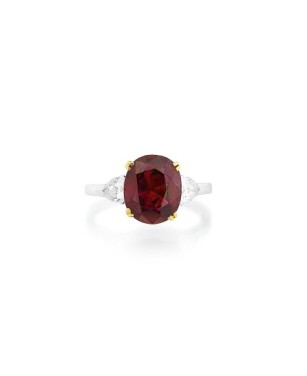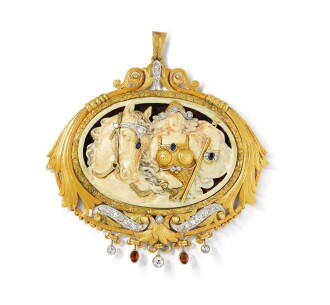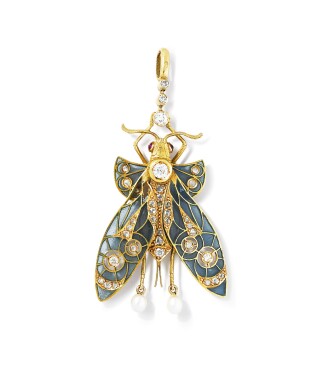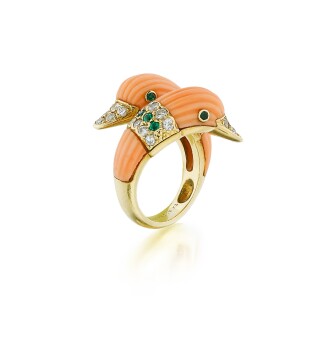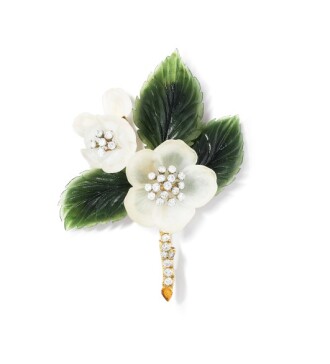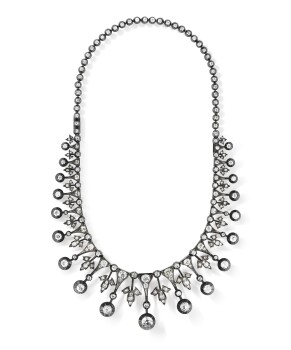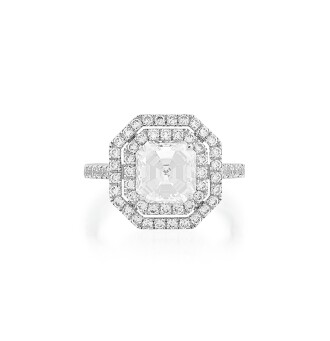T o end the summer on a high note, diamonds will sparkle in the spotlight of Sotheby's September Jewellery sale. With several exceptional stones of over seven carats each, this sale promises to shine.
Our Fine Jewels sale is unveiling a beautiful collection of jewellery signed Masriera and Fuset y Grau, two important names in the early 20th-century.
It also includes the great names of “Haute Joaillerie” : Cartier, Bulgari, Boucheron, as well as Van Cleef & Arpels with a coral version of its emblematic “Alhambra” sautoir.
Featured Highlights

The artistic movement Modernisme, influenced by Art Nouveau, took root in Barcelona in the 1880s. Although best known for its architectural expression, the movement extended to all areas of the decorative and fine arts. At the end of the 19th century, Catalonia was a rich and powerful region seeking to emancipate itself from Castilian Spain. This is the period known as the Catalan Renaissance, whose ideals were conveyed and disseminated by the artistic flourishing of the Modernist movement with Barcelona its dynamic epicenter. Many writers, poets, architects and artists settled there, participating in the renewal of the city whose identity was strongly marked by artists such as Antonio Gaudi and Lluis Domenech i Montaner. Their intention was to create a style that reflected the Catalan soul while ensuring that the aesthetics of Barcelona kept their uniqueness.
The Modernista style is characterized by curved and undulating lines, the use of floral and Moorish motifs; a blending of Catalan tradition and mythology reflected in the bright colours that can be found throughout the city of Barcelona. Numerous Modernist buildings such as the Casa Batllo, the Palau de Musica Catalana, the Sagrada Familia, and the Parc Güell were constructed at this time.
It was this impetus of modernity that led to Lluis Masriera’s melting down the totality of the old stock from the family jewellery shop in order to create an entirely new collection. Six months later, this bold move was met with success. His creations are emblematic of a style filled with symbolism and mystery and all of his pieces are adorned with dazzling polychrome enamels of remarkable quality, demonstrating the virtuoso mastery of the Masriera workshops.
Fuset y Grau, also based in Barcelona, draws inspiration from the city. Alongside the highly innovative architecture, the city still preserves old neighbourhoods such as the Barrio Gotic, where one finds Roman ruins as well as buildings dating from medieval times. The creations of Fuset Y Grau are unique, just like the city where they were born, and representative of a style that combines elements of Gothic architecture and Catalan craft traditions with a repertoire of modernist ornamentation.


Featured Lots

Ornamental stones, known as hardstones, are increasingly used in Haute Joaillerie. Their appeal comes from the intensity of their deep colours and the fascinating beauty of their naturally graphic designs. The undulating lines of the malachite, the veins of agate, the ferns of dendritic agate, the deep colour of the lapis lazuli, the silken effect of tiger's eye, are all sources of inspiration for jewellery designers. They stand apart from other gems by their opacity and are often simply polished or cut into cabochons. Widely used in the jewellery of antiquity, ornamental stones are also found in Art Nouveau creations as a material more affordable than precious stones.
During the Art Deco period, designers such as Jean Després and Suzanne Belperron carved directly into hardstones such as rock crystal to create the volumes used in their architectural pieces. In the 1960s, Jean Vendome made an enduring impression on the jewellery world by using raw crystals and varieties of stones previously neglected by the major houses. One of his favourite stones was rutilated quartz, which he did not hesitate to saw open to make slices that he would then set, as seen in his "Echo" brooch. Today it is not uncommon to find gemstones and ornamental stones mixed together in the creations of Haute Joaillerie houses, a blend of tradition and mystery.
Read LessFeatured Lots
- 1880s
- End 19th Century
- 1910s
- 1920s
- 1930s
- 1940s
- 1950s
- 1960s
- 1970s
- 1980s
- 2010s
-
Silver braceletEstimate: 2,000 - 4,000 EUR
Of bangle design, celebrating the centenary of the French Revolution, inner circumference approximately 180mm, French assay marks for silver, gross weight 56.15 grams; late 19th century. -
 WestImage - Art Digital StudioDiamond necklaceEstimate: 10,000 - 15,000 EUR
WestImage - Art Digital StudioDiamond necklaceEstimate: 10,000 - 15,000 EUR
Set throughout with circular-cut diamonds, length approximately 390mm, French import assay marks for silver and 9 carat gold, gross weight 67.62 grams; late 19th century. -
Masriera | Enamel, pearl and diamonds broochEstimate: 3,200 - 5,200 EUR
Picturing a maiden holding a brilliant-cut diamond, surrounded with floral designs applied with plique-à-jour enamel and circular-cut diamonds, measuring approximately 48 x 70mm, signed, French import assay marks for 18 carat gold and platinum, gross weight 24.19 grams; early 20th century. -
Onyx, sapphire and diamond braceletEstimate: 14,000 - 16,000 EUR
The hinged openwork links of floral design, set with single- and circular-cut diamonds, onyx and circular-cut sapphires, length approximately 170mm, French assay mark for platinum, maker's mark, gross weight 38.66 grams; circa 1925, case stamped A. Michelsen. -
Sapphire and diamond braceletEstimate: 30,000 - 40,000 EUR
Set throughout with circular-cut and baguette diamonds, the centre collet-set with a cushion-shaped sapphire, length approximately 185mm, French import assay marks for platinum and 18 carat gold, gross weight 77.32 grams. -
Gold braceletEstimate: 3,500 - 5,500 EUR
Designed as a series of geometrical links, length approximately 210mm, French assay mark for 18 carat gold and French import assay mark for 18 carat gold, gross weight 109.99 grams; 1940s. -
Pair of diamond ear clipsEstimate: 1,800 - 2,000 EUR
Each of flower design, set with brilliant- and carré-cut diamonds, measuring approximately 31 x 25mm, French import assay marks for 18 carat gold and platinum, combined gross weight 27.79 grams. -
Van Cleef & Arpels | Gold and Diamond Powder CompactEstimate: 8,000 - 12,000 EUR
Of basket weave design, the thumbpiece similarly set, opening to reveal a powder compartment and mirror, measuring approximately 83 x 57 x 18mm, signed Van Cleef & Arpels, numbered, French assay mark for 18 carat gold and maker's mark for Van Cleef & Arpels, gross weight 165.90 grams; 1960s. -
Van Cleef & Arpels | Coral sautoir, 'Alhambra'Estimate: 26,000 - 30,000 EUR
Set with twenty quatrefoil motifs set with coral, length approximately 810mm, signed Van Cleef & Arpels, numbered, French assay marks for 18 carat gold, instinct maker's mark, gross weight 48.21 grams. -
Zolotas | Silver and gold necklaceEstimate: 800 - 1,200 EUR
Set with silver and gold beads, the centre decorated with two lion heads, length approximately 395mm, signed Zolotas, French import assay marks for 18 carat gold and silver, gross weight 83.56 grams, pouch stamped Zolotas. -
Marchak | Diamond and emerald ringEstimate: 150,000 - 200,000 EUR
Claw-set with a step-cut diamond weighing 5.01 carats, the mount pavé-set with circular-cut emeralds, size 521/2, signed Marchak, numbered, French assay mark for silver, gross weight 7.57 grams.
The Timeless Allure of Diamonds
Two thousand years ago, Pliny the Elder wrote that diamonds, given their rarity, could only be destined for kings and queens. Diamonds have a long history; even the most recent ones were formed in the depths of the Earth some 70 million years ago. This unique gem is composed of a sole chemical element, carbon. It is its simple composition and internal crystal structure that gives it its hardness, its resistance to chemicals and its extraordinary brilliance. Brought to the surface by volcanic eruptions, diamonds are mined from kimberlite, an igneous rock. They can also be found in the alluvial deposits of rivers.
As early as the 4th century, diamond deposits were known in India. In the 18th century, the high demand for these stones from the European royal courts led to their being rapidly exhausted. It was at this moment that new mines were discovered in Brazil in the region of Minas Gerais. Then, in 1866, a new and even more important deposit was discovered in South Africa and thousands of prospectors from all over the world flocked there hoping to make their fortune. Today, the main diamond deposits are concentrated in African countries such as Botswana, Congo and Angola. Other countries such as Russia, Australia or Canada are also producers.
Its adamantine brilliance, which makes it so desirable, is revealed by the way it is cut, a technique that has evolved over the centuries. It was, in fact, the use of rough crystal that continued to spread until the 14th century, when the crystal began to be polished and faceted. Diamond cutting improved again in the 20th century due to a greater understanding of physics and optics. It was Marcel Tolkowsky who created the modern cut with its 54 facets, thus bringing the “fire” of the diamond to its ultimate expression.
Read Less


